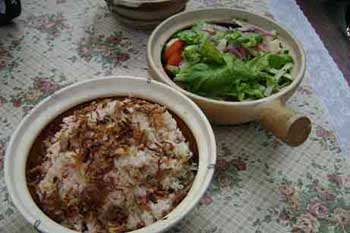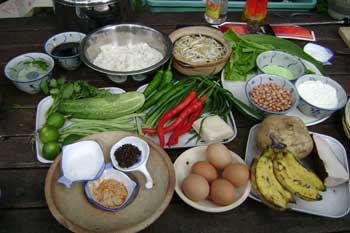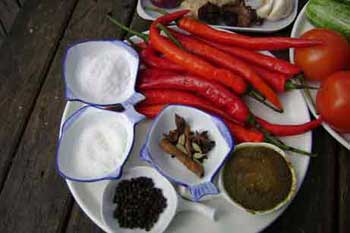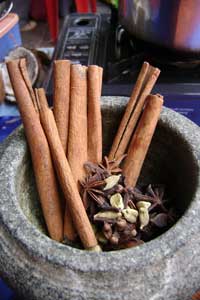
|
||
|
Follow @Nazlina
More About CardamomMore about cardamom can be read here. You have probably heard of Turkish coffee, which is flavored with this spice. I once drank a cup of this strong coffee, it gave me a headache because I was not used to it.
Cardamom is one of the world’s very ancient spices. It is native to the East originating in the forests of the western ghats in southern India, where it grows wild. Today it also grows in Sri Lanka, Guatemala, Indo China and Tanzania.
Cardamom pods are generally green but are also available in bleached white pod form. They are dried in the sun or bleached with sulphur fumes. In Malaysia, the bleached version is more common and I was a bit surprised to see the green variety when I was living in England. Malay cooks use the pods whole instead of powder form. More about cardamom...The ancient Egyptians chewed cardamom seeds as a tooth cleaner; the Greeks and Romans used it as a perfume. Vikings came upon cardamom about one thousand years ago, in Constantinople, and introduced it into Scandinavia, where it remains popular to this day. Its use in Scandinavian cooking is much more popular than cinnamon.
Cardamom is an expensive spice, second only to saffron. It is often adulterated and there are many inferior substitutes from cardamom-related plants, such as Siam cardamom, Nepal cardamom, winged Java cardamom, and bastard cardamom. However, it is only Elettaria cardamomum which is the true cardamom. Indian cardamom is known in two main varieties: Malabar cardamom and Mysore cardamom. The Mysore variety contains higher levels of cineol and limonene and hence is more aromatic. White-bleached pods are also available. The pods are roughly triangular in cross section and oval or oblate. Their dried surface is rough and furrowed, the large ‘blacks’ having deep wrinkles. The texture of the pod is that of tough paper. Pods are available whole or split and the seeds are sold loose or ground. It is best to buy the whole pods as ground cardamom quickly loses flavour. The pods can be used whole or split when cooked in Indian substantial meals — such as pulses. Otherwise, the seeds can be bruised and fried before adding main ingredients to the pan, or pounded with other spices as required.
Keep the pods whole until use. The pod itself is neutral in flavour and not generally used, imparting an unpleasant bitter flavour when left in dishes. Cardamom is used mainly in the Near and Far East. Cardamom is used in Danish pastries, Saudi Arabian, North African, Asian, and Indian cooking and in spice blends such as garam masala and curry powder.
More about cardamom in European dishes and other usesIts commonest Western manifestation is in Dutch ‘windmill’ biscuits and Scandinavian-style cakes and pastries, and in akvavit. It is featured in curries, essential in pilaus (rice dishes) and gives character to pulse dishes. Cardamom is often included in Indian sweet dishes and drinks. At least partially because of its high price, it is seen as a ‘festive’ spice. Other uses are; in pickles, especially pickled herring; in punches and mulled wines; occasionally with meat, poultry and shellfish. It flavors custards, and some Russian liqueurs. Cardamom is also chewed habitually (like nuts) where freely available, as in the East Indies, and in the Indian masticory, betel pan. Some old Malays also practice the chewing of the betel nut with betel leaves. It is addictive because the substance (betel nut) has mild narcotic properties. Cardamom is a flavoring for Arab and Turkish coffee which is served with an elaborate ritual. More about cardamom plantsCardamom comes from the seeds of a ginger-like plant. The small, brown-black sticky seeds are contained in a pod in three double rows with about six seeds in each row. The pods are between 5-20 mm (1/4”-3/4”) long, the larger variety known as ‘black’, being brown and the smaller being green. A perennial bush of the ginger family, with sheathed stems reaching 2-5m (6-16 feet) in height. It has a large tuberous rhizome and long, dark green leaves 30-60 cm (1-2 ft) long, 5-15 cm (2-6”) wide. It grows in the tropics, wild and in plantations. Trailing leafy stalks grow from the plant base at ground level. These bear the seed pods. The flowers are green with a white purple-veined tip. That is enough on information on more about cardamom, let's move on to other spices. Back to the page of Malay spices

Custom Search
|

Custom Search
Nazlina's Cooking Class in PenangAttend my cooking class to learn making traditional food.
The morning class includes Penang Market Tour.
PLEASE NOTE: We now offer PM classes, for vegan and vegetarians. |
|
|
|
||
|
|
||



 It is also one of the
most common Malay spices.
It is also one of the
most common Malay spices. 


New! Comments
Have your say about what you just read! Leave me a comment in the box below.